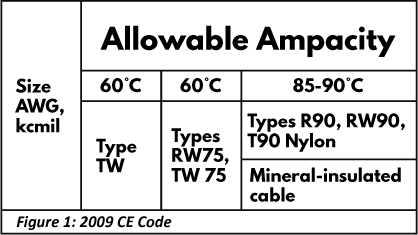This article contains our technical opinions and is for general information purposes only. In this article, the term “cable” can refer to a conductor, wire, or cable.
Tables 1 to 4 of the CE Code (CSA C22.1) are the most commonly used ampacity tables for sizing electrical cables in Canada. However, there has been some confusion over amendments made to these tables over the years.
In this article, we examine the source of the confusion and clarify which ampacity temperature column to use for selecting cable sizes.
Before the Implementation of Rule 4-006 Temperature Limitation Rule
Prior to 2012, Tables 1 to 4 in the CE Code incorporated the current Table 19 cable types into the temperature rating column headers, as shown in figure 1. Contractors and electrical designers selected an ampacity from the table column based on the cable type they were using. Circuits using common cable types like RW90 or Teck90 cable were sized based on 90°C column ampacities, which matched information commonly listed in cable spec sheets at that time.
As part of an ongoing CE Code/NEC (National Electrical Code for the USA) code harmonization process, some subtle but significant changes to the method ampacities came into effect in the 2012 CE Code.

After the Implementation of the 4-006 Temperature Limitation Rule
In 2012, the 4-006 Temperature Limitation Rule was implemented. Cable types were removed from the column headers in Tables 1 to 4, as shown in figure 2. Most of the ampacities in the columns were also changed. At first glance, it appeared that acceptable ampacities had increased, allowing you to use smaller cables, but this was not the case. The new rules in 4-006 require the cable ampacities to be based upon the lowest temperature rated component in the circuit. In many cases, designers and contractors had to select larger gauge cables based on ampacities from a lower temperature ampacity column.

As an example, prior to 2012, the majority of Teck90 cable sizes were based upon the Table 1 to 4’s 90°C column ampacities. Now, those same circuits are limited to 75°C due to the termination temperature ratings of equipment at one or both ends of the circuit. In this case, the conductors may be 90°C rated but the circuit conductor’s ampacity must now be selected from the more derated 75°C column due to termination temperature limitations. In most situations, contractors and electrical designers now had to shift from using the 90°C column to using the 75°C column.
These changes created confusion and extra work for electrical designers who had to redesign their systems, retrain staff, and become familiar with the new elements of the cable selection process. Many electrical designers who had relied upon manufacturer spec sheet ampacities now risked specifying cables that were undersized per the current CE Code.
Which ampacity column should you use to size your cables, 75°C or 90°C?
Refer to Table 19 for the allowable insulation temperature rating of the cable you are going to use. Then find the temperature rating of the components that your conductors are going to terminate onto. Refer to Rule 4-006 [2] if the information is not available.
The item (component or cable) with the lowest temperature rating will determine what column you can use (75°C / 90°C column on Tables 1-4). Check Rule 4-006 [3,4,5,6] for any exceptions.
For instance, if you are using three RW90 conductors in conduit (90°C rated per Table 19) that are being terminated to circuit breaker with a temperature rating of 75°C, you would use the 75°C column in Table 2 to select the conductor size. The same applies to cables with a higher temperature rating (105°C).
Avoid relying upon the manufacturer’s spec sheet ampacities as they might not match current CE Code tables or be based upon an ampacity temperature column not meeting your component requirements.
Conclusion: The CE Code ampacity table / rule changes have allowed for a cable sizing method that is consistent across the border and better reflects the temperature limitations of all components in a circuit. This has resulted in safer electrical systems being designed and installed in Canada.

For more information on cable installation and sizing, read our articles on medium voltage cable sizing CE code ampacity table D17, cable pulling calculations, how to handle low temperature cables, and minimum cable bend radius for power & control.

